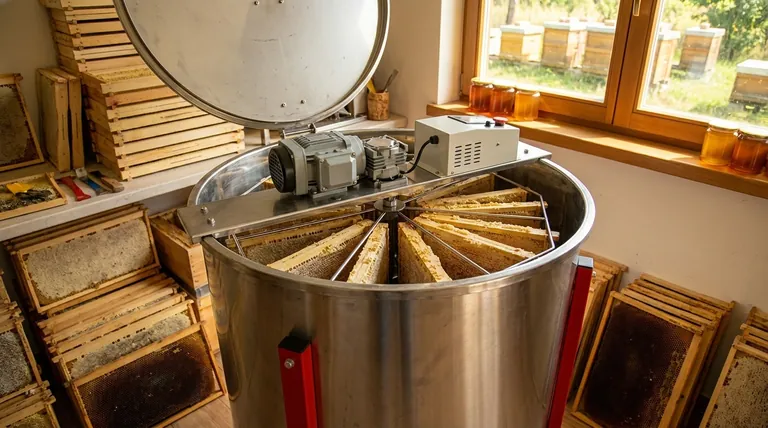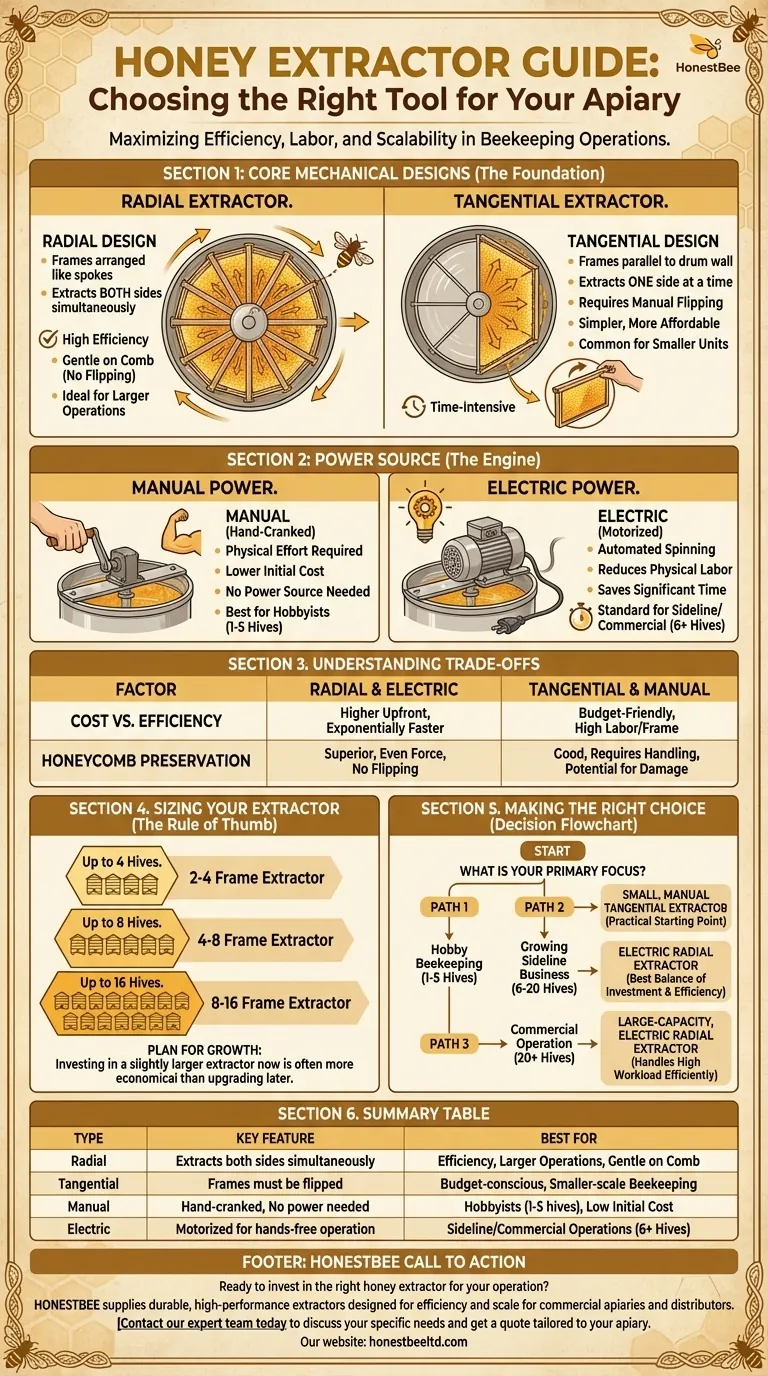At its core, a honey extractor is categorized by two key factors. The first is its power source—either manual (hand-cranked) or electric. The second, and more fundamental distinction, is its mechanical design: either tangential, where frames must be flipped, or radial, where both sides are extracted simultaneously.
Your choice of honey extractor is not just about convenience; it's a strategic decision that directly impacts your efficiency, labor, and ability to scale your beekeeping operation. Understanding the core designs is more critical than the power source alone.

The Two Core Designs: Radial vs. Tangential
The internal layout of an extractor determines how it processes your honey frames. This is the most significant difference between models.
How a Radial Extractor Works
In a radial extractor, frames are arranged like the spokes of a wheel, with the top bar of the frame facing outwards.
As the basket spins, centrifugal force pulls honey out from both sides of the comb simultaneously. This design is highly efficient and minimizes the need to handle the frames during extraction.
How a Tangential Extractor Works
A tangential extractor holds the frames with one side of the comb facing the wall of the drum.
You spin the frames to extract honey from the first side, then you must stop, physically flip each frame, and spin again to extract from the second side. This design is simpler and often found in smaller, more affordable units.
The Less Common Variant: Parallel Radial
A third type, the parallel radial extractor, is also available. It orients the frames to combine aspects of both designs but is less common for small-scale and hobbyist beekeepers.
The Power Source: Manual vs. Electric
This choice is about balancing cost, convenience, and the scale of your operation.
The Case for Manual Extractors
A manual extractor is powered by a hand crank. It requires your physical effort to get the basket spinning at the necessary speed.
These are excellent for beekeepers with only a few hives. Their primary advantages are a lower initial cost, mechanical simplicity, and the ability to operate without a power source.
The Advantage of Electric Extractors
An electric extractor uses a motor to spin the basket, automating the most labor-intensive part of the process.
This is the standard for anyone with more than a handful of hives. It dramatically reduces physical labor and saves a significant amount of time, allowing you to process large quantities of honey efficiently.
Understanding the Trade-offs
Choosing an extractor involves balancing clear benefits and limitations.
Cost vs. Efficiency
A small, manual tangential extractor is the most budget-friendly entry point. However, the time and labor required per frame are high.
An electric radial extractor requires a much larger upfront investment but processes honey exponentially faster, making it more cost-effective for larger apiaries.
Honeycomb Preservation
Using any extractor is vastly superior to the "crush and strain" method, as it preserves the delicate beeswax comb. This saves the bees an immense amount of energy on the next honey flow.
Radial extractors are generally gentler on the comb because the force is distributed evenly and the frames do not need to be handled and flipped midway through the process.
Sizing Your Extractor Correctly
The capacity of your extractor should match the size of your apiary, with consideration for future growth.
The Rule of Thumb
The number of hives you manage is the best indicator of the extractor size you need. A good guideline is:
- Up to 4 hives: 2-4 frame extractor
- Up to 8 hives: 4-8 frame extractor
- Up to 16 hives: 8-16 frame extractor
Planning for Growth
Beekeeping has a way of expanding. If you anticipate adding more hives in the next few years, investing in a slightly larger extractor now is often more economical than needing to sell and upgrade later.
Making the Right Choice for Your Apiary
Your specific goals should guide your final decision.
- If your primary focus is hobby beekeeping (1-5 hives): A small, manual tangential extractor is the most practical and economical starting point.
- If your primary focus is a growing sideline business (6-20 hives): An electric radial extractor offers the best balance of investment and time-saving efficiency.
- If your primary focus is a commercial operation (20+ hives): A large-capacity, electric radial extractor is the only tool that can handle the workload efficiently.
Choosing the right extractor is a direct investment in your time, the health of your bees, and the quality of your honey harvest.
Summary Table:
| Type | Key Feature | Best For |
|---|---|---|
| Radial | Extracts both sides of the frame simultaneously | Efficiency, larger operations, gentle on comb |
| Tangential | Frames must be flipped mid-process | Budget-conscious, smaller-scale beekeeping |
| Manual | Hand-cranked, no power needed | Hobbyists (1-5 hives), low initial cost |
| Electric | Motorized for hands-free operation | Sideline/commercial operations (6+ hives) |
Ready to invest in the right honey extractor for your operation?
HONESTBEE supplies commercial apiaries and beekeeping equipment distributors with durable, high-performance extractors designed for efficiency and scale. Our wholesale-focused operations ensure you get the professional-grade equipment you need to maximize your honey harvest and protect your valuable comb.
Contact our expert team today to discuss your specific needs and get a quote tailored to your apiary.
Visual Guide

Related Products
- 8-Frame Electric Self-Reversing Honey Extractor Spinner for Commercial Honey Extraction Equipment
- 40 Frame Commercial Electric Honey Extractor for Beekeeping
- Commercial Electric 12 Frame Honey Extractor Spinner Motorized Honey Extractor
- Electric 8 Frame Honey Spinner Extractor Equipment for Beekeeping
- HONESTBEE 3-Frame Manual Acrylic Honey Extractor
People Also Ask
- What size honey extractor is recommended for different hive sizes? Maximize Your Harvest Efficiency
- What are the size and power variations in honey extractors? Optimize Your Harvesting Efficiency
- What is a honey extractor and how does it benefit beekeepers? Boost Honey Yield & Hive Health
- What factors should be considered when choosing a honey extractor machine? Maximize Your Harvest Efficiency
- What should a beekeeper do after extracting honey from supers? A Guide to Harvest Management



















